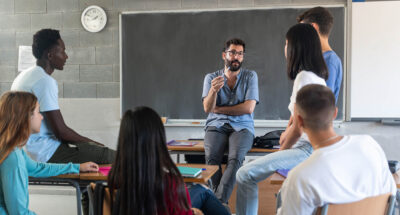
Facilitating Bridging Discussions
Educators will reflect on, and learn tips about, how to best engage in “bridging differences” discussions about justice and equity in the classroom.

Educators will reflect on, and learn tips about, how to best engage in “bridging differences” discussions about justice and equity in the classroom.
Educators will:
Through these practices, students will engage in the following terms related to bridging differences and pursuing justice. Oftentimes conflict with others who seem different from us or who hold different opinions is caused by a misunderstanding of terms and definitions. In other words, language. Hence, it is important for both you and your students to understand the terms listed below that are used in the practices when engaging in this work.
Bridging differences and discussing equity and justice can lead to difficult, vulnerable, or uncomfortable moments in your classroom. While allowing students to share their beliefs openly, it is important to recognize when a comment is harmful to others or interferes with the protocol or safety of the classroom environment.
It is also important to make a plan to say this in advance of discussions in anticipation of difficult moments occurring, and repeating this preface often to clarify expectations. Furthermore, it’s important to recognize if you don’t have the resources or preparation to facilitate a given conversation. Consider taking small steps and having short conversations to begin so there is a build up of success and practice before more intense topics and lengthy discussions are planned.
At the same time, make a commitment to grow in your skills so that you can ensure that the perspectives of marginalized groups are heard. The inequities that marginalized people experience can be invisible to those who don’t experience them. What’s more, when they share their experiences, their peers can receive these perspectives with disbelief or defensiveness. While these conversations can be difficult to facilitate, they are essential to prepare for and have so that all voices–especially those that have been stifled historically–are welcomed and respected. You can seek out the support of trusted colleagues to build your skills and competence to navigate these important discussions.
Follow the tips in this handout to help you prioritize maintaining a brave, safe space and student well-being while challenging students to identify, unpack, and confront biases and stereotypes as well as seek justice.
Making Caring Common, Harvard Graduate School of Education
Teens need support in building their skills to participate in solving problems within existing structures within society. They also need to learn how to recognize when these societal structures perpetuate inequities and how to take collective action to foster justice.
Researchers compared two different high school programs in the United States where students learned about democracy and citizenship. One program focused on participatory citizenship in an East Coast suburban/rural high school (almost all students were European Americans). The other program focused on justice-oriented citizenship in a West Coast urban high school (38% African American, 38% Asian or Pacific Islander, 5% Latino, 5% White, 10% Other; 40% lived in public housing).
The results? Both programs were successful in achieving each of their goals, but also had different outcomes based on their priorities. Compared to before each of the programs, teens in both groups followed the news more frequently, felt greater civic efficacy, and supported greater government responsibility for those in need after completing the programs.
Teens in the participatory citizenship program also felt greater personal responsibility to help others and greater leadership efficacy following the program. They also had a clearer vision of what to do for their community, and had greater knowledge of the skills needed for community development. What’s more, teens in the justice-oriented citizenship program also had greater understanding between structural and individual explanations for poverty, and greater interest in politics following the program.
The researchers highlighted that teens benefit from both types of program priorities–nurturing participation and cultivating the ability to analyze the underlying structural biases that lead to injustice–because focusing on promoting one does not guarantee the other will be fostered automatically in teens as well.
Equity and justice involve basic human rights for all people, but the majority of children across the world are living with inequity and injustice. What’s more, these unfair realities affect not just the development of children from marginalized identities because privileged children bear witness and are influenced by the existence of inequity and injustice, as well. In many cases, privilege is derived from exploiting children and communities from particular identities, which have negative ripple effects on entire societies.

Do you want to dive deeper into the science behind our GGIE practices? Enroll in one of our online courses for educators!
Comments